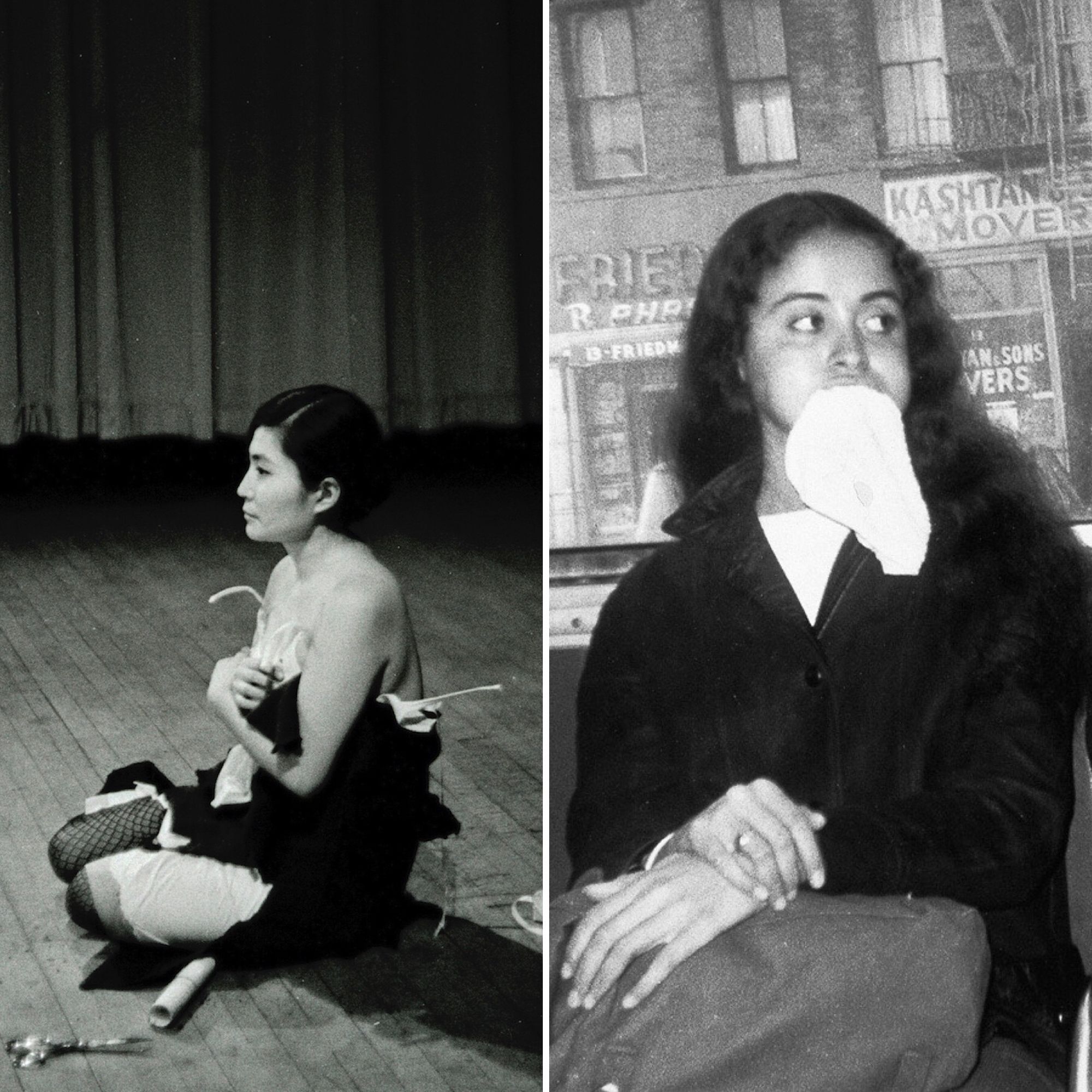Bodies of Culture

LOOK
This week in my seminar on artist's books at Cooper Union we are looking at publications by a diverse group of women from the 1960s and 1970s, including Yoko Ono's 1964 Grapefruit and Adrian Piper's 1974 Talking to Myself: The Ongoing Autobiography of an Art Object. These books are connected to the artists' performances, which led me to think about Ono's Cut Piece from 1964 (above left) and Piper's Catalysis IV from 1971 (right).
The photograph depicts Cut Piece at Carnegie Hall, during which Ono sat on the stage with a pair of scissors beside her and invited audience members one by one to cut a portion of her clothes and take the fragment with them. Ono's performance responds to composer John Cage's experiments with chance during the 1950s and George Brecht's event scores, which consist of simple instructions. Ono called her scores "instruction pieces" and the earliest of these in Grapefruit date to 1960.
Instead of the theater, Piper's performance of Catalysis IV took place on a New York City bus and in other everyday locales. In this performance, she took a large white bath towel, stuffed it into her mouth, and let the remainder hang down. As she writes in Talking to Myself, her performance responds to other artists' investigations into space during the 1960s. Whereas Donald Judd sought to investigate an abstract "real space" through imposing sculptures made from large industrial materials, Piper investigated the power of her own body, racialized as Black, and its ability to affect others within the social space of an urban environment.
Although many focus on violence when discussing Cut Piece, I see the work differently as about care and community. Ono invites members of the audience to remove and receive a gift of her clothing if they are able to take care of her body in the process. The conditional nature of the gift is implicit, but it safeguards Ono's wellbeing, as does the protection of the community in which she performs: the audience and the theater's staff. In contrast, Piper's performances take place amidst an unsuspecting public. Her actions break social conventions and the audience is free to retaliate in keeping with societal norms. Viewed by her public as an anonymous Black woman on the stage of the everyday in a white supremacist culture, Piper's actions involved significant personal risk. The stakes of Piper's chance encounters with her public are so high that Ono's open-ended performance seems almost predictable in comparison.
ACT
You may be vaguely aware about the assault on higher education in Florida at the moment. The folks in the non-profit newsroom The 19th have the best article I've seen breaking down the pending Flordia House Bill 999 and its ban on the teaching of gender and ethnic studies in higher education. The American Council of Learned Societies has issued a statement signed by numerous professional organizations, including the College Art Association. Students are protesting while university presidents remain silent.
LEARN
The next session of my lunchtime Zoom workshop Looking at Art to Nurture Your Child runs from April until May on Tuesdays or Thursdays for 4 weeks. Curious about how to connect with your child around art? Join us! Free orientation sessions on 4/18 and 4/20.
LISTEN
On the latest episode of the Pre-Raphaelite Podcast, art historian Roberto Ferrari talks about the Jewish-sibling artists Simeon, Rebecca and Abraham Solomon in Victorian London. Tune in to learn about the queerness of Simeon and Rebecca's feminism.
The art historian Jennifer Shaw was recently featured on an episode of the podcast The Alarmist (Apple Podcast / Google Podcast), where she discusses the life and work of the queer French surrealist Claude Cahun and her partner Marcel Moore, including their acts of resistance during the Nazi occupation.
SEE/VISIT
A new exhibition opened this week in London at the Tate on the Pre-Raphaelite artists Dante Gabriel Rossetti, Elizabeth Siddal, Fanny Cornforth and Jane Morris. The exhibition was recently featured in the London Times (paywalled link here.)
The exhibition After Impressionism: Inventing Modern Art also just opened at the Tate in London. Check out this trailer for the exhibition and some great installation photos.
The library at Cambridge University is exhibiting their collection of over 1,000 lithographs depicting caricatures that were distributed during the the Franco-Prussian War and the Paris Commune (1870-1). If you can't make it to Cambridge, check out the exhibition website, which comes with a great film.
Thank you for reading. Feel free to send along your thoughts. Until next week!